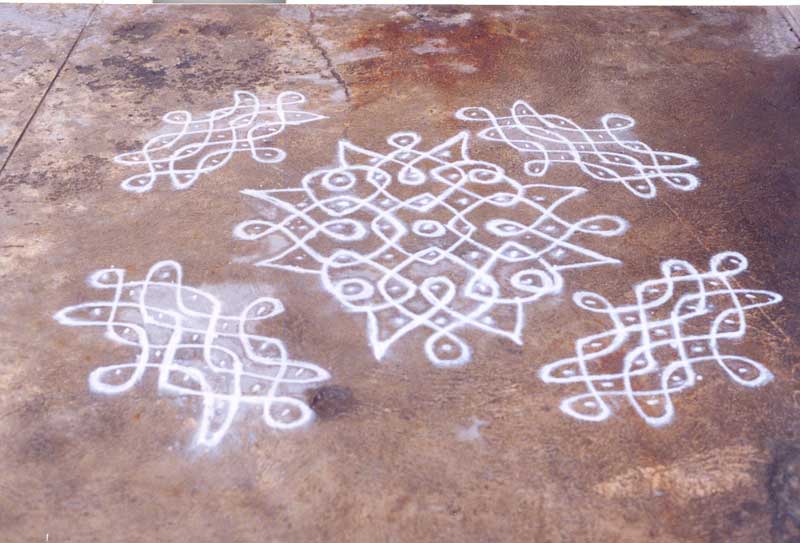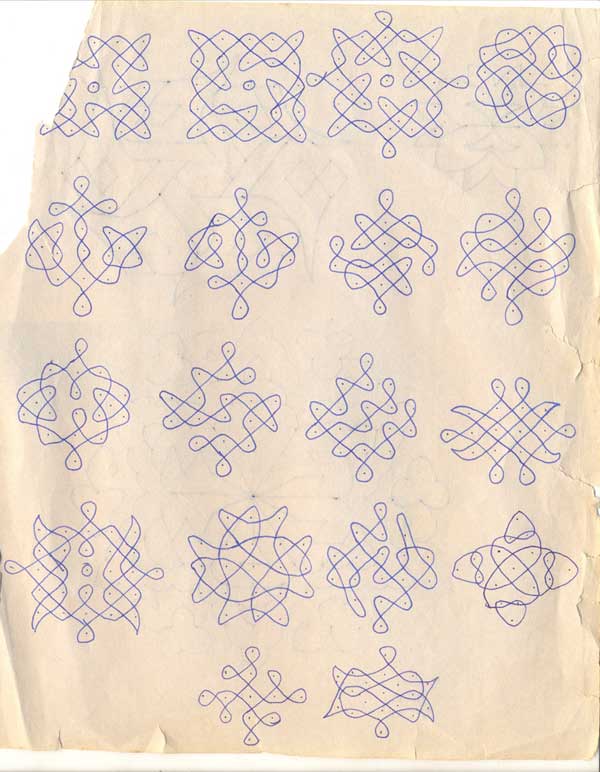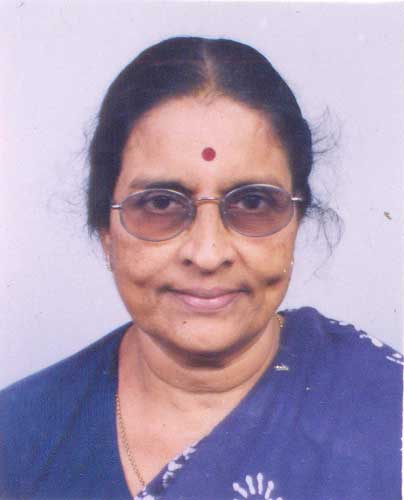Contribute
| South Asian Art History - In Memory Of Prashant H. Fadia |
Ramaa Narayanan
02/08/2007
Continued from the previous issue.. The point - the dot is a tantric symbol – bindu. It is a symbol of the infinite; for between two dots placed one over the other is stretched the Infinite. It is point where the identity of the individual soul is realised, as it merges with the universal soul. It is point where all living beings unite. Line is but a moving dot; a traversing dot; a string of dots. Line, according to John Layard (Labyrinth Ritual in South India : Threshold and Tattoo) has many meanings chief of which are line current, water course, snake ornament (tattoo) and planet Saturn. Kolam line is sutra - Thread of Life thus symbolizes continuity. The continuous line of kolam may be said to signify the cyclic process of cosmic phenomenon on the one hand and the very karma - the cyclical concept of cause – effect – cause- effect on the other. At times, kolam is constellation sun, moon and stars as patterns. But more importantly it is ‘journey’: kolam in essence is point, line, plane, movement and Infinite. Being a folk expression, pullikolam appears freely in many types and forms though traditional patterns are treasured. The variegated designs range from basic geometric shapes to naturalistic bells, ribbons and bunny rabbits. Religious symbols like swastika, five or six pointed star are the most common. From the world of flora, leaves of mango and vilva, lotus flowers, snake- gourd , pagarkodi (bitter-gourd creeper), as well as mullai pandal (jasmine arbour) are expressed as patterns. Tulsi plant is depicted along with its plant holder. Parrot, hamsa, annam, peacock as well as snakes are meaningful forms from fauna. Sacred objects of conch, kalas(pot), lamp, especially kutthu vilakku recur. Favourite objects like chandana pela , panneer chombu , as well as ornaments like jhimiki , bullakku are fascinating as patterns. Chariot , swing, palanquin, cradle and simple wooden seat – a plank (manai) - find varied expression . On the one hand, the more common abstract non-subject pullikolam patterns have tremendous visual appeal. On the other, things of nature and every objects comprise charming patterns when translated into computational kolams; their attraction lies in certain ‘literalness’ of expression that allows easy recognition of their forms of origin. The pulli kolams are meant to be learnt, memorized and drawn on floor on day to day basis; or / and on occasions. The design scope of this everyday art of kolam is of astounding aesthetic order, stemming from arithmetical order. In the recent times, 'literalness' has crept in as a wave of modernization. Unfortunately, a number of modern kolams are representational depictions, rather than patterns. Things of contemporary life offer endless possibilities for innovations; yet it is well to bear in mind that computational kolam is essentially a pattern art in white. Learning pullikolam and repeating them is by itself a rich experience. (Glossary: kutthu vilakku - bronze lamp of Tamil Nadu .It has a base , a stem, a wide dish shaped container and a crown
Pullikolam is linear, in keeping with the aesthetic preferences of the land. The dots – lines relationship within pullikolam emphasizes another important design feature. The lines may connect the dots absorbing them in the process and resulting in shape based patterns - geometric or near geometric patterns or even quasi- naturalistic forms. Alternately and often times lines traverse - spinning around points. The lines dancing around the dots in wavy manner - plait like, river like, serpent like, woven - thread like - in knots and weaves is alluring. Thus kolam needs no other design element like colour to throw its beauty in relief. The all white patterns of velvety dots and silvery lines are truly evocative. Kambi kolam and Izhai kolam are two terms that deserve attention in the context of line quality. Kambi refers to ‘metal wire’ line - tenuous and firm, while izhai cannotes ‘thread-fibre’ line - soft and yielding . Layard emphasises the importance of continuous lines; for evil spirits ‘enter’ thorough the gaps. It is common belief that the continuous line help prevent entry of evil spirits. Thus warning is against loose ended or overlapping or ‘throwback’ lines. The significant feature is that the line is cyclical either in simple circles and loops; or winding in algorithmic complexity it comes back to from whence it started. It is true that there is no beginning or end in the kolam lines. Though the lines may be drawn in a preset movement continuously to the particular count of dots as though following a pre-ordained path - it is a loop after all. These computational kolams thus enshrines infinity through continuous traversal of one or a series of loops.
Fundamental to kolam aesthetics is the simple structure of the basic unit with tremendous scope for development and variation. Symmetry prevails over variety; rhythm over emphasis. Though pulli–kambi kolam looks extremely complex there is an underlying order that is arithmetical. A whole kolam may comprise a single loop or a single kolam may be constructed of many intertwining loops. There is invariably a basic unit used alone as a complete kolam; or the basic unit is employed in various ways - two units making mirror images, four making a square or lozenge, or many units forming a circle, octagon and so on. The basic module is expanded systematically in all or any direction. The essential design properties of kolam allow for logical and methodical development of a basic design as much as combining of one or many patterns that may possess a common denominator.
Scale is a noteworthy design principle of kolam. For instance, a particular pattern in chandupullikolam may be done in a sequence of seven dots in the middle row to one dot on either side or twenty one dots in the middle to one dot on either side. Drawn either big or small each kolam pattern is bewitching in itself and ‘fills' the area metaphorically, irrespective of its actual size. The kolam artist looks around the place and intuitively decides on the scale and size; selects from memory the kolam for the occasion and time. Working by the measure of the eye and her intuitive and creative instincts she implants the dots, draws the lines and eye- catching kolam emerges. It may be the one she had learnt in her childhood days from her grandmother, she improvises as she draws. Thus even a simple and old pattern is presented with a refreshing skill and is imbued with a distinct aesthetic appeal.
chandana pela - a wide mouth container on a high base used for holding sandal paste for convenient use
panneer chombu- rose-water sprinkler
jhimiki - a pendant ear ornament
bullakku - a nose ornament)
You may also access this article through our web-site http://www.lokvani.com/

One Plus Four Kolam

A page from Ramaa

Dr. Ramaa Narayanan